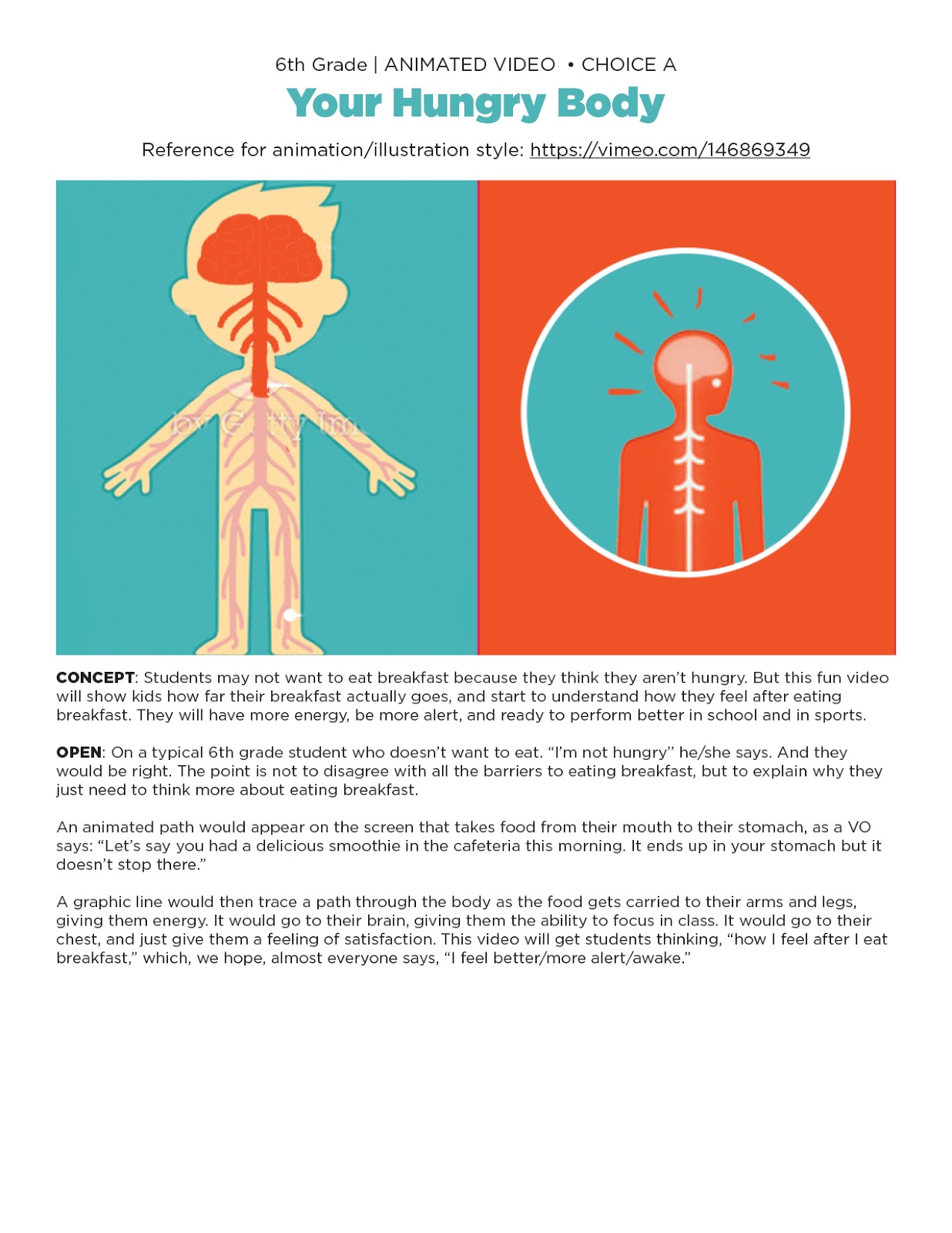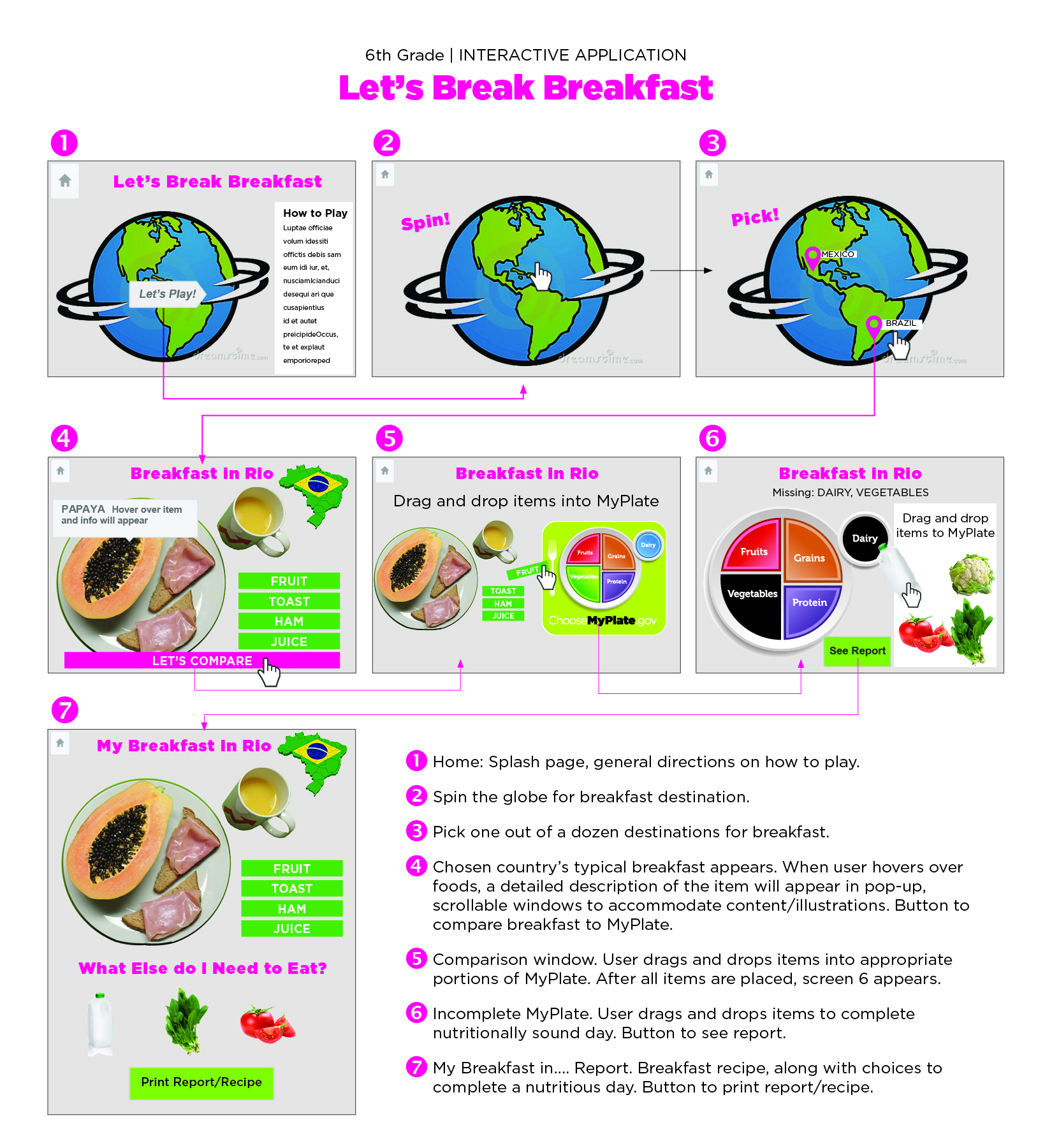Middle School Digital Nutrition (SLT)
Generic Clearance to Conduct Formative Research
Attachment M_Focus Group Stimulus_Grade 6-rev
Middle School Digital Nutrition (SLT)
OMB: 0584-0524
OMB Control Number: 0584-0524 | Expires 06/30/2016
Attachment M
OMB BURDEN STATEMENT: According to the Paperwork Reduction Act of 1995, no persons are required to respond to a collection of information unless it displays a valid OMB control number. The valid OMB control number for this information collection is 0584-0524. The time to complete this information collection is estimated at 15 minutes, including the time for reviewing instructions and completing the information collection.
6th GRADE: “The GEOGRAPHY About Food”
Key Message: Eat a Healthy Breakfast Every day
Secondary Message: MyPlate Recommendations
6th Grade | INFORMATIONAL TEXT ARTICLES
MyPlate
Health and Academic Benefits of Eating a Healthy Breakfast
Possible Question Stems
Based on 6th Grade Common Core Standards:
Theme/Idea (Reading Literature (RL) 6.2, Reading for Information (RI) 6.2):
What is the central idea/theme...?
Summarize the text without judgment. What was the author’s main point in paragraph x?
Word Use (RL 6.4, RI 6.4):
In line xx, what does the word ____ mean...? (i.e. What does the term food group mean?)
What is the technical meaning of the word...? (i.e. How are the five food groups defined?)
Point of View / Purpose (RL 6.4, RI 6.6):
From whose point of view is this text written...?
Which of the following best describes the author’s purpose...?
Which of the following are opposing this author's point of view...?
Arguments / Claims (RI 6.8):
Which of the following is the argument presented in this passage...?
Which of the following quotes supports the development of this passage’s argument...?
Which of the following evidence supporting the argument is most relevant...?
Article 1: MyPlate
This informational text article will explain the MyPlate model and help students discover how eating the MyPlate way will help them grow, play, and do well in school. The article will tie into the subject areas of Geography and Social Studies by exploring where popular foods in the five food groups are grown throughout the United States.
Educational topics covered:
MyPlate illustrates the five food groups (Dairy, Fruits, Vegetables, Grains, Milk, and Protein foods) that are the building blocks for a healthy diet using a familiar image — a place setting for a meal.
You can feel good, grow strong, and stay healthy by eating the MyPlate way every day.
Eating the MyPlate way gives you more of the nutrients you need to grow, play, and do well in school. Choosing an eating style with more nutrient-dense foods and less added sugars and sodium can help you stay healthy and manage your calories, too.
MyPlate is an eating pattern that should be followed throughout the day.
Fill half your plate with fruits and vegetables, and choose fruits and vegetables at meals and snacks.
Make half your grains whole grains.
Choose lean protein foods.
Drink 2-3 cups of low-fat or fat-free milk each day.
MyPlate is based on the Dietary Guidelines for Americans.
Subject area tie-in: Geography / Social Studies
The article will focus on 5 specific foods, one from each food group, and explore where they are grown throughout the United States. (i.e. the majority of tomatoes grown in the U.S. are grown in California.) Identified foods and supporting statistics will come from AMS and/or the agricultural census.
Article 2: Breakfast Around the World
This informational text article will cover the importance of eating breakfast and how it can help give you the energy you need to start the day. The article will connect to the subject areas of Geography and Social Studies by exploring how cultures around the world eat different kinds of breakfasts.
Educational topics covered:
Breakfast is an important meal for all students.
Cultures around the world serve different foods for breakfast.
Many breakfast foods from around the world are very different from what we eat in the United States.
Fish, rice, and vegetable stew are some popular breakfast foods in other countries.
Millions of children around the world (including the U.S.) may not have any breakfast at all.
A balanced, nutrient-dense breakfast helps...
Give you energy
You recharge after a long night’s rest
You move and be active
Improve your concentration
You do well on school work and tests
You maintain a healthy weight
A balanced, nutrient-dense breakfast should be low in sodium, saturated fat, and added sugar.
A good breakfast will have multiple food groups represented.
Subject area tie-in: Geography / Social Studies
Explore how cultures around the world eat different kinds of breakfasts.
6th Grade | LESSON PLANS
Messages
Key Message: Every morning, you should eat a healthy breakfast that includes a variety of foods from different food groups. These foods should be low in added sugars, saturated fat, and sodium. Eating breakfast at school is a great way to get a quick, easy, and balanced breakfast each morning.
Secondary: Identify the five food groups.
Lesson Outline
Transfer Objective
Students will be able to independently use their learning from these activities to:
Increase the number of days they eat healthy breakfast foods.
Learning Objectives
Students will be able to:
Describe the five food groups.
Explain the short term and long term benefits of eating a healthy breakfast.
Identify food groups in breakfast foods.
Evaluate a breakfast and/or breakfast item as being well-balanced (nutrient-dense, and low in added sugars, saturated fat, and sodium) or not.
Enduring Understandings
Eating breakfast gives you the energy you need to start the day.
Eating a well-balanced breakfast can help you make smarter food choices for the rest of the day.
Schools provide a convenient, quick, and easy healthy breakfast each day.
Skipping breakfast can make it hard for your brain to concentrate and for your body to move throughout the day.
Essential Questions
Why is it important to eat breakfast?
What are the breakfast habits of people around the world?
What is a healthy breakfast?
Activities
Read “MyPlate” and “Breakfast Around the World” informational text articles
Answer comprehension questions
Answer class discussion questions
Analyze two breakfasts using MyPlate guidelines
Find a copy of your school’s breakfast menu. Analyze a day’s offering using the MyPlate guidelines: What food groups are included? What food groups are missing? What are some things you would you need to eat for lunch and dinner in order to have all five food groups?
Use the interactive component to identify a breakfast served from a place outside of the U.S. Analyze the breakfast based on the MyPlate guidelines. What food groups are included? What food groups are missing? What are some things you would you need to eat for lunch and dinner in order to have all five food groups?
Standards
Global Perspective
Cultural Awareness
Understand importance of a healthy breakfast
Challenge and Investigation (handout to be created)
Track your breakfast habits throughout the week and note how you feel at certain points during the day using a handout.
Interactive Application Tie-in
The interactive will complement the informational text articles and be used as one of the lesson activities. Students will explore what people typically eat for breakfast in different countries around the world, and see how they align with MyPlate. If sections of MyPlate are missing, kids will explore how to incorporate those food groups into the rest of their day.
Video Tie-in
The video will serve as an introduction to the entire lesson by showing students why eating a healthy breakfast is important.

Note: all claims about breakfast benefits will be based on backed by peer reviewed, science-based research.

T his
journey around the world will open up a 6th grader’s mind to
the many creative breakfast options available, and get them to
rethink how they start their day. At each point on the map, a menu of
options will be offered, giving a range of information about
breakfasts in different countries. The “Let’s Compare”
button will show how a typical breakfast in another country compares
to MyPlate. If food groups are missing, students will be given
recommendations for how to incorporate the missing food groups into
the rest of their day. All information points can be printed so that
students can share meal ideas with their friends and family. Global
meals will be selected from trusted resources such as USDA and FAO.
his
journey around the world will open up a 6th grader’s mind to
the many creative breakfast options available, and get them to
rethink how they start their day. At each point on the map, a menu of
options will be offered, giving a range of information about
breakfasts in different countries. The “Let’s Compare”
button will show how a typical breakfast in another country compares
to MyPlate. If food groups are missing, students will be given
recommendations for how to incorporate the missing food groups into
the rest of their day. All information points can be printed so that
students can share meal ideas with their friends and family. Global
meals will be selected from trusted resources such as USDA and FAO.
| File Type | application/vnd.openxmlformats-officedocument.wordprocessingml.document |
| Author | Carla Berger |
| File Modified | 0000-00-00 |
| File Created | 2021-01-23 |
© 2025 OMB.report | Privacy Policy